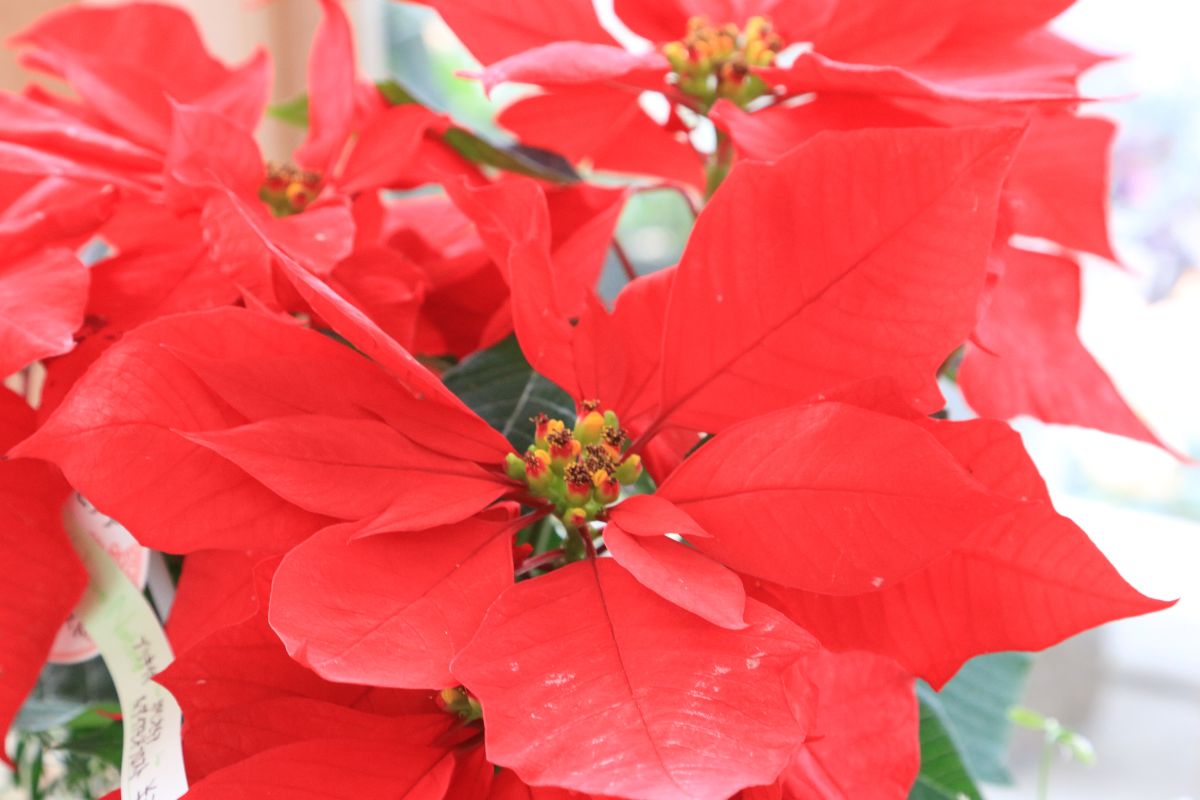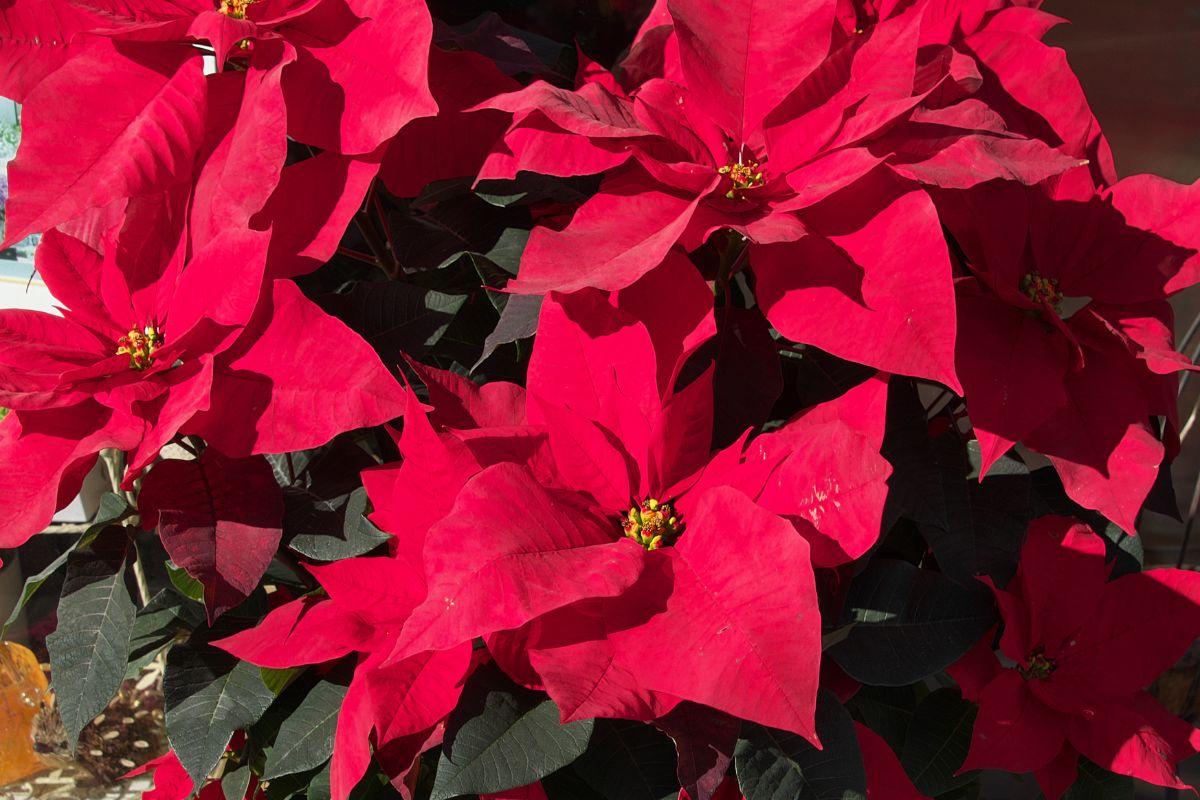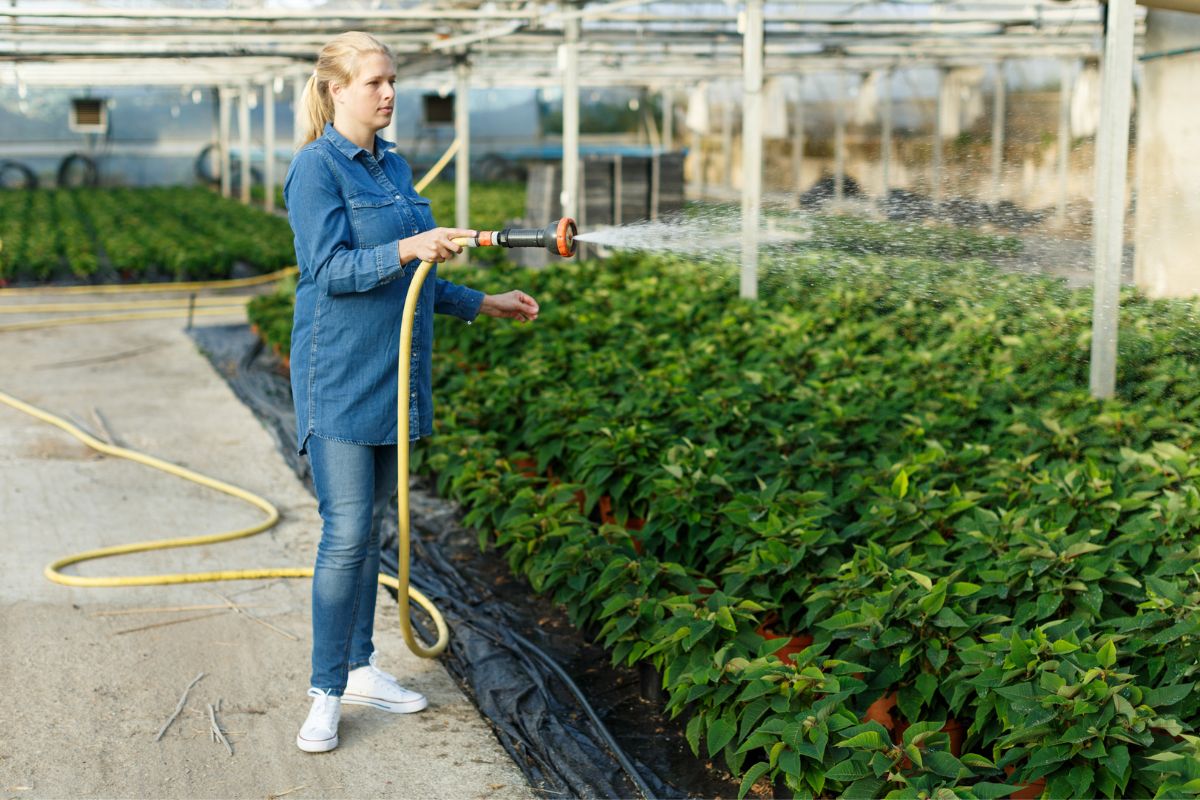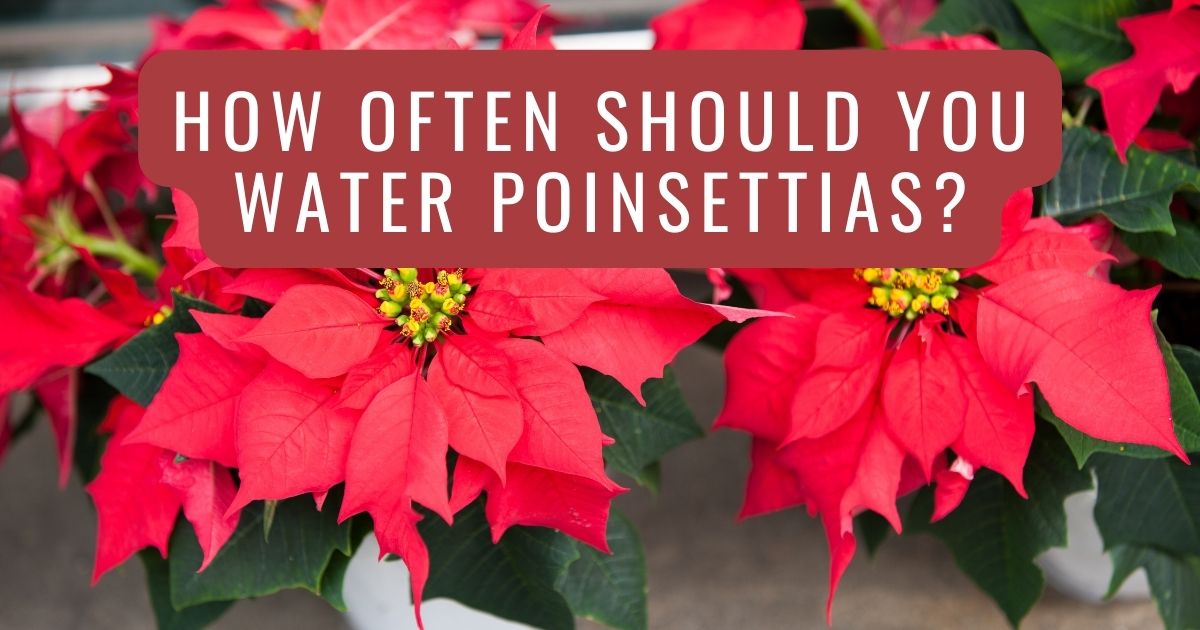Watering Poinsettias
Poinsettias are little shrubs that naturally grow in Mexico’s tropical deciduous forests, but for most of us, they brighten our homes during the winter holidays. How often should you water Poinsettias? Poinsettia plants can be challenging to water, although caring for these classic beauties isn’t tough.
What volume of water do poinsettias require? How should you water a poinsettia plant? If you have questions, keep reading to find out.

Is There a Difference Between Indoor and Outdoor Watering?
Indoor Watering
Watering is always the main worry for new plant owners. We’d all like to know when and how much water to give our houseplants. As was already stated, it all relies on the requirements of each plant.
Beginners also want to know how to water thoroughly without creating a complete mess. In addition to the methods mentioned above, the following advice for beginners is available:
Drain Any Extra Water
Most plants dislike having wet feet, just like people do. It might result in root rot. The answer? After watering, empty the saucer of any extra water.
Recognize How Much a Well-Watered Plant Weighs.
So you want to water effectively without creating a mess? Once the dirt soaks, lift the pot to feel the weight. Every time you water, do this, and you’ll soon be able to calculate the precise amount of water to use based on the weight of the pot.
Water Indoor Plants at the Sink
This tactic is undoubtedly in use even by inexperienced plant parents. It’s an easy fix to stop spilled liquid from spilling into the carpet when you empty your saucers.
Permit Chlorine to Vaporize for a Full Day
A frequent component of tap water is chlorine. It can hinder plant growth and destroy soil bacteria. It has a greater impact on some indoor plants than others. Fill the watering can and let it sit for a day before watering if you want to remove the chlorine from your water.
Outdoor Watering
In addition to the general recommendations listed above, the following advice can help new gardeners water their outdoor plants more successfully:
Water First Thing in the Morning
Since the morning is the coolest part of the day, less water evaporates. Additionally, any extra moisture on the leaves dries out when the sun rises. When you water plants in the evening, moisture remains on them all night, fostering fungus such as powdery mildew.
Combine Plants That Require Equal Amounts of Water.
This will simplify everything and guarantee that each plant receives just the amount of moisture required.
Give the Appropriate Quantity of Water
Beginners frequently water excessively out of fear that they won’t water enough, but this is wasteful and adds unnecessary costs to your water bill. Rain in the wide outdoors gives us another factor to think about. In Chicago land, the weather can be unpredictable, but as a general rule, at least a half-inch deep rain replaces one watering.
You’ll conserve a lot of water while enjoying a beautiful garden if you consider rain when planning your watering routine.
How Often Should You Water Poinsettias?
How often do you water Poinsettias? Poinsettias don’t require frequent watering. Poinsettias only require watering every week or ten days, but keep in mind that every home is different and that you should always check them. Always make sure the poinsettia soil is dry before watering.
The preferred method for determining a poinsettia’s water level is to take up the pot and weigh it; this eliminates the need to stick your finger into the ground. Use this method if you don’t detest the feeling of dirt gathering under your fingernails.
It’s time to give the poinsettia pot a drink when it becomes quite light. Poinsettias originate from the jungle, where the shallow soil soon dries out. They’re used to arid environments. Bring the poinsettia up to the threshold of wilt, but keep it from fully drying out and flagging. Plants should not wilt in this manner.
When the poinsettia is completely dry, please give it a good watering until water drops from the drainage holes in the container. There are several ways to water poinsettias:
- To water thoroughly, point the tip of your watering can or cup at the soil line. A different set of problems could arise if water spills over the leaves.
- Place the poinsettia pot in a shallow dish filled with about 2 inches (5 cm) of water, remove the lid if it has one, and allow the pot to soak up water for 15 to 20 minutes.

How to Water Poinsettias
How often should you water Poinsettias indoors? As soon as you get the poinsettia home, check the bottom of the pot. It’s crucial to drill a hole as soon as you can if the pot doesn’t already have at least one drainage hole. The roots may decay pretty fast if the pot cannot drain.
Additionally, removing any decorative foil can make the poinsettia happier because it might contain water that can damage the plant. Ensure the foil is completely drained after each watering if you are not yet prepared to remove the pot’s shiny covering.
The ideal method for watering poinsettias plants is to place them in the kitchen sink and slowly saturate them with water until they drip out of the drainage hole. Set the pot on a plate or tray after letting it stand in the sink to allow any extra moisture to drain.
Never let the pot float in the liquid. Keep the poinsettia where it gets six to eight hours of direct sunlight daily. Keeping the plant away from drafts and heat vents will prevent the leaves from dropping.
How Much Water for Poinsettias?
Too much watering is just as detrimental to poinsettia plants as not enough. The top of the potting soil, which should feel damp and cold to the touch, is the best place to assess whether a poinsettia needs water. Water is necessary if the soil seems dry. Additionally, if you can raise the pot with little effort at all, the soil is excessively dry.
You should never saturate the potting soil or soaking wet, just slightly moist. Potting soil can quickly dry out in warm, indoor air, so it’s best to check the plant daily to be safe. Soon enough, you won’t need to check the plant as frequently to determine how much water it needs.
The Appearance of an Overwatered Poinsettia
If your poinsettia appears ill, overwatering may be the root issue. So, look at the warning signals that your plant is getting too much water. One of the most noticeable symptoms of a dry plant is wilting.
However, did you realize that withering can also indicate overwatering? And this is a hard one because people often give plants additional water while they are withering. So, feel your plant’s soil to determine whether it is wilting due to overwatering or underwatering. When watering a Poinsettia, you must provide it with water if the soil is dry.
However, if the soil is moist and your plant droves, overwatering is the cause. You can find yet another sign of overwatering on the leaves of your poinsettias. Are they all healthy and green, or are some of them also brown and yellow? Another indication of overwatering is if the leaves on your poinsettias turn brown and fall off.
Oxygen levels in the soil will reduce by overwatering. Your plant can suffocate due to its inability to absorb the required nutrients. Small white spots or blisters on the leaves are another indicators of edema that you should watch out for. This also occurs when your plant takes in too much water.
Last but not least, overwatering is always to blame if your poinsettia exhibits root rot symptoms. Root rot sets up when the soil is consistently damp, as occurs in severe overwatering. Always look out for these signs of an overwatered Poinsettia.
Do Poinsettias Re-Bloom Annually?
Some gardeners want to conserve the plants so they will bloom the following winter again since they don’t draw satisfaction with this prolonged season of interior beauty. If you take good care of your poinsettias, they will bloom yearly if you keep them. When moving the plants, in particular, keep them from freezing. Please put them in a well-lit area that is free from drafts.
They prefer temperatures between 55 and 65 degrees Fahrenheit (1.62 and 1.92 degrees Celsius) at night, and during the day, 65 and 70 degrees Fahrenheit (1.92 and 2.07 degrees Celsius ). You should not keep poinsettias in chilly areas or expose them to temperatures below 50 degrees Fahrenheit (1.48 degrees Celsius).
How to Re-Bloom Poinsettias
Poinsettias can blossom with care. Some people only use poinsettias as Christmas decorations. For a healthy start, remove the poinsettia from the foil or cut holes in the bottom so water may drain. You should remove it from a basket to water it. Water your poinsettia’s roots and soil, not the leaves.
Watering it in the sink ensures that excess water can run away. Poinsettias don’t like to be constantly wet, so you should only water them when they need it. Start fertilizing the poinsettia in March. Peter’s or Miracle-Grow are good water-soluble fertilizers. Cut the poinsettia down to 6 to 8 inches (15.24 to 20.32 centimeters) between March and April. Keep fertilizing and watering.
After the risk of frost has passed, move your poinsettia outside to a shady, wind-protected spot.
Always water and fertilize. If they’re not in plain sight, you may forget about them. 3 to 5 weeks should be rough. The half-day sun makes them fuller and more compact. Over a week or two, gradually expose them to the morning sun.
You can repot the plant now or plant it in a well-drained bed with organic debris. Choose a pot with drainage holes and a larger diameter of 4 to 6 inches (10.16 to 15.24 centimeters). Use good potting soil. We like Fafard. Regularly water and fertilize. If it’s too huge, prune it again in August. Don’t prune after Labor Day.
Long fall nights trigger poinsettia flowers and leaf coloring. A momentary light will make the poinsettia think it experienced two short nights instead of 1 long night, delaying blooming. From 5 pm to 7 am, put the poinsettia in a closet or box. Water as needed for eight weeks (it won’t need as much as before). Till thanksgiving, fertilize.
Thanksgiving to March is fertilizer-free. Put the poinsettia in a window-lit room during the day. They need sunlight for optimal color and to avoid leaf drop. Your poinsettia should bloom by Christmas with proper care.

That’s a Wrap
When you consider their origins, poinsettias are extremely easy to care for. Since poinsettias are tropical plants native to Mexico, they have simple but distinctive requirements. Poinsettia care is as simple as 1-2-3. This article will give you all the knowledge you need to grow Poinsettias, Poinsettia watering, and Poinsettia water requirements to be successful.
